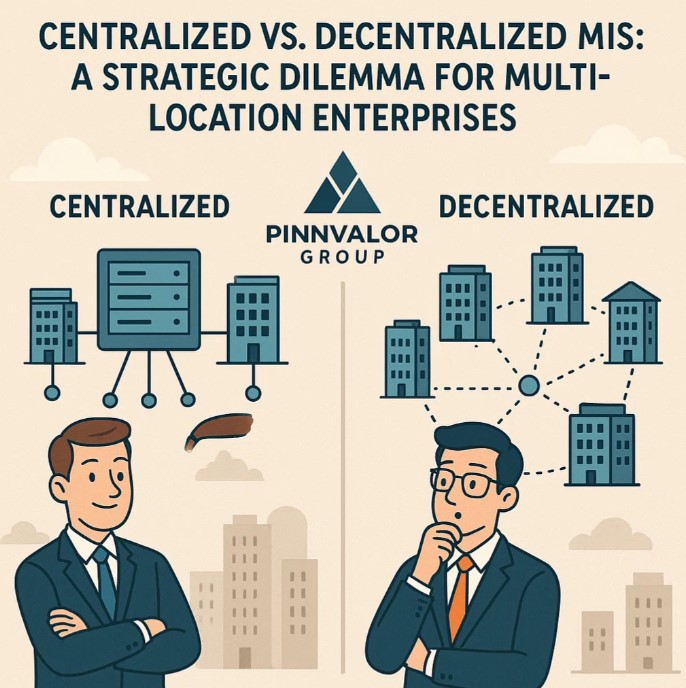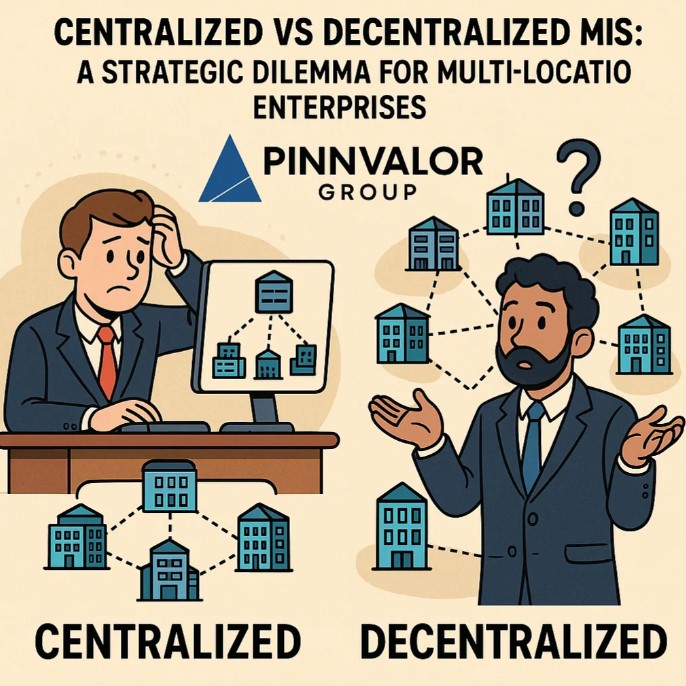
Centralized vs Decentralized MIS: A Strategic Dilemma for Multi-Location Enterprises
In today's data-driven world, Management Information Systems (MIS) are vital tools that enable organizations to collect, process, and analyze business data for informed decision-making. For multi-location enterprises, implementing and managing MIS effectively becomes more complex due to geographical dispersion, varied operational needs, and differences in regulatory environments.
Can your multi-location business afford the wrong MIS strategy?
The real power of MIS lies not in the system—but in how it fits your business model.
A fundamental strategic question arises:
Should MIS be centralized or decentralized?
This blog explores both models in depth, comparing their benefits and drawbacks, and offers guidance for enterprises on finding the right approach for their needs.
🔍 Understanding MIS in a Multi-Location Context
A Management Information System supports planning, control, coordination, and decision-making within an organization. In multi-location enterprises — such as retail chains, manufacturing groups, or global service providers — the MIS must bridge physical and functional boundaries while ensuring consistency, security, and adaptability.
The structure of MIS in these enterprises can take two primary forms:
- Centralized MIS: All data and system management are controlled from a single central location.
- Decentralized MIS: Each location or regional office has autonomy over its own data systems and processes.
🏛️ Centralized MIS: Pros and Cons
✅ Advantages
- Consistency and Standardization
A centralized system ensures uniformity in data collection, formats, and reporting standards across all branches. - Cost Efficiency
Centralized infrastructure can reduce IT overhead by avoiding duplication of hardware, software, and staff. - Better Control and Governance
Centralized systems allow for more robust policy enforcement, access control, and cybersecurity measures. - Improved Data Accuracy and Reporting
Consolidated data can be analyzed more effectively, enabling stronger strategic decisions at the enterprise level.
❌ Challenges
- Reduced Flexibility
Local branches may find it difficult to adapt quickly to regional needs if they rely on a central office for every system update or data change. - Slower Response Times
Centralized decision-making can delay operational responses at the local level, especially in time-sensitive scenarios. - Scalability Issues
As the enterprise grows, maintaining a single point of data processing can lead to performance bottlenecks.

🏢 Decentralized MIS: Pros and Cons
✅ Advantages
- Greater Autonomy and Responsiveness
Local offices can respond quickly to regional needs, regulations, or customer preferences. - Tailored Systems
Decentralized MIS allows customization based on specific location requirements, which can improve local efficiency. - Reduced Central Load
By distributing the workload, decentralized systems can scale more flexibly without overloading a central server.
❌ Challenges
- Data Fragmentation
Without a unified structure, data may become siloed, inconsistent, or duplicated across locations. - Higher IT Costs
Each location requires its own infrastructure and support, potentially increasing overall costs. - Compliance and Security Risks
Varying standards and oversight at each location can lead to vulnerabilities in data governance and regulatory compliance.
⚖️ Choosing the Right Approach: Key Considerations
- Business Model and Operational Structure
Is the enterprise highly centralized in its decision-making, or does it promote local autonomy? Retail chains may benefit from centralization, while franchise models might require decentralization. - Regulatory Environment
In some industries or regions, data localization laws may necessitate decentralized systems. Enterprises operating in multiple countries must navigate GDPR, HIPAA, and other local data protection regulations. - Technological Readiness
Cloud platforms, hybrid IT, and edge computing now allow more flexible models — including centralized control with decentralized execution. - Scalability and Growth Plans
Consider how easily your MIS strategy can scale with your business expansion, especially into new regions or countries.
🌐 Hybrid Approaches: The Best of Both Worlds?
Many modern enterprises are turning to hybrid MIS models, combining centralized oversight with decentralized capabilities. This approach offers:
- Central data governance and compliance
- Local adaptability and autonomy
- Scalable cloud-based infrastructure
- Unified dashboards with drill-down local insights
Technologies like Enterprise Resource Planning (ERP) systems, cloud-based MIS platforms, and Business Intelligence (BI) tools make hybrid models increasingly viable.
📌 Conclusion
The debate between centralized and decentralized MIS isn’t about finding a universally correct answer — it’s about aligning your MIS strategy with your business goals, operational model, and technological environment.
For multi-location enterprises, the ideal MIS structure is often a strategic blend — ensuring global oversight while empowering local action.
Before deciding, conduct a thorough analysis of your current systems, organizational culture, compliance landscape, and growth trajectory. With the right approach, your MIS can become a powerful asset driving insight, agility, and sustained competitive advantage.
